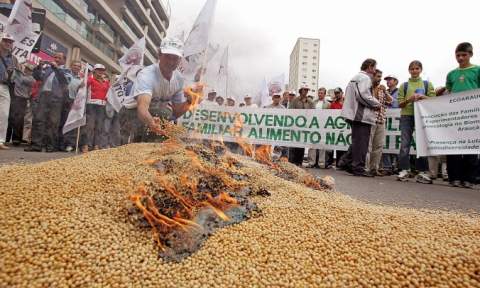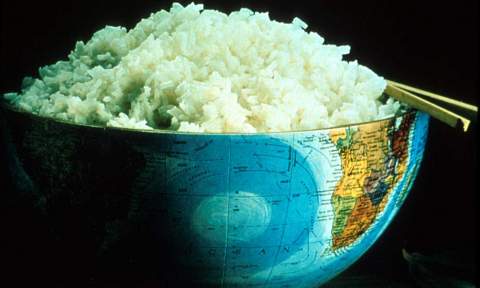- Pilot study shows build-up of glyphosate herbicide in Mothers’ bodies
- Urine testing shows glyphosate levels over 10 times higher than in Europe
- Initial testing shows Monsanto and Global regulatory bodies are wrong regarding bio-accumulation of glyphosate, leading to serious public health concerns
- Testing commissioners urge USDA and EPA to place temporary ban on all use of Glyphosate-based herbicides to protect public health, until further more comprehensive testing of glyphosate in breast milk is completed.
In the first ever testing on glyphosate herbicide in the breast milk of American women, Moms Across America and Sustainable Pulse have found ‘high’ levels in 3 out of the 10 samples tested. The shocking results point to glyphosate levels building up in women’s bodies over a period of time, which has until now been refuted by both global regulatory authorities and the biotech industry.
The levels found in the breast milk testing of 76 ug/l to 166 ug/l are 760 to 1600 times higher than the European Drinking Water Directive allows for individual pesticides. They are however less than the 700 ug/l maximum contaminant level (MCL) for glyphosate in the U.S., which was decided upon by the U.S. Environmental Protection Agency (EPA) based on the now seemingly false premise that glyphosate was not bio-accumulative.
Glyphosate-containing herbicides are the top-selling herbicides in the world and are sold under trademarks such as Monsanto’s ‘Roundup’. Monsanto’s sales of Roundup jumped 73 percent to $371 million in 2013 because of its increasing use on genetically engineered crops (GE Crops).
The glyphosate testing (1) commissioned by Moms Across America and Sustainable Pulse also analyzed 35 urine samples and 21 drinking water samples from across the US and found levels in urine that were over 10 times higher than those found in a similar survey done in the EU by Friends of the Earth Europe in 2013.
The initial testing that has been completed at Microbe Inotech Labs, St. Louis, Missouri, is not meant to be a full scientific study. Instead it was set up to inspire and initiate full peer-reviewed scientific studies on glyphosate, by regulatory bodies and independent scientists worldwide.
The initial testing was done using ELISA tests and due to a high minimum detection level in breast milk and urine, it is possible that even those samples which tested negative contained ‘worrying’ levels of glyphosate.
Moms Across America Founder and Director, Zen Honeycutt, stated Monday, “When I was told by several doctors and labs that I could not test my own or my children’s urine for the most widely used herbicide in the world over a year ago, I became determined to find a way. Parents and citizens deserve the ability to be able to take care of themselves and their families by finding out if herbicides could be impacting their health. The purpose of this glyphosate testing project is to shed light upon the presence of glyphosate in our water, children’s bodies and mother’s breast milk, hopefully inspiring further scientific studies to support the world in being a healthy, safe place to live.
“The mothers tested are mostly familiar with GMOs and glyphosate. Most of them have been trying to avoid GMOs and glyphosate for several months to two years, so the levels of mothers who are not aware of GMOs and glyphosate may be much higher,” Honeycutt concluded.
High Glyphosate Levels – Danger for Infants?
There is currently no regulatory limit for the amount of glyphosate in breast milk anywhere in the world. However, the EPA has set a legally enforceable maximum contaminant level (MCL) for glyphosate of 700 ug/l in drinking water, which is 7,000 times higher than the MCL in Europe.
Monsanto and regulatory bodies worldwide have based all of their regulations on the assumption that glyphosate is not bio-accumulative. Senior Monsanto scientist, Dan Goldstein, even recently stated (2), “If ingested, glyphosate is excreted rapidly, does not accumulate in body fat or tissues, and does not undergo metabolism in humans. Rather, it is excreted unchanged in the urine.”
The discovery of levels of glyphosate in breast milk that are much higher than any reported results for urine samples is a source of concern to both the general public and government regulators worldwide, as the data suggests that glyphosate is bio-accumulative; building up in people’s bodies over a period of time.
Earth Open Source Research Director Claire Robinson said, “Regulators and industry always say it is the dose that makes the poison, and even the increasing levels of glyphosate currently found in food and feed and the environment are not a problem. However, that argument only holds true if glyphosate doesn’t build up in the human body and is excreted as fast as we take it in. These breast milk results suggest glyphosate may bio-accumulate. That means that our body tissues might be exposed to higher levels than the so-called safe levels set by regulators. So the regulations are not protecting us.”
From a total of 10 samples sent in by Mothers from states across the U.S., 3 women had detectable levels of glyphosate in their breast milk. The highest glyphosate level was detected in a mother from Florida (166 ug/l) and the other two mothers with ‘positive’ results were from Virginia (76 ug/l) and Oregon (99 ug/l).
Dr Angelika Hilbeck, senior scientist at the Institute of Integrative Biology in Zurich, stated, “If confirmed in a full investigation, it seems that glyphosate has become a ubiquitous chemical in terms of presence and persistence. This data also offers a first indication of potential accumulation in the human body, giving newborns a substantial dose of synthetic chemicals as a ‘gift’ for their start into life, with unknown consequences. This is reckless and irresponsible conduct in a democratic society, which still has a living memory of previous reckless chemical contaminations, such as DDT. It seems we either did not learn, or we have forgotten, our lessons from Rachel Carson! (3)”
Jessica M. from Virginia, one of the mothers who tested positive for glyphosate in her breast milk, said, “It is frightening to see any glyphosate in my body, especially in my breast milk that will then contaminate my son’s growing body. It’s particularly upsetting to test positive for glyphosate because I go to great lengths to eat organic and GMO free. I do not consume any meats or seafood and only very rarely eat dairy. This really shows me, and should show others, just how pervasive this toxin is in our food system.”
Honeycutt added, “Moms Across America feels very strongly that breast milk should still be the number one choice for mothers and certainly preferred over GMO soy formula ingredients. We just urge all mothers to eat as organic as possible, especially avoiding meat, dairy, oils and grains that are sprayed with glyphosate at harvest as a drying agent.”
“What we have found encouraging is that the women who have been eating organic and non-GMO very strictly, for several months to two years, did not find detectable levels of glyphosate in their breast milk.”
Why Are Glyphosate Levels in Urine Higher than in Europe?
In 2013 people in 18 countries across Europe were found to have traces of glyphosate in their urine by a test commissioned by Friends of The Earth Europe (4). The maximum levels of glyphosate found in the tests ranged from 0.16 ug/l in Switzerland to 1.82 ug/l in Latvia.
Shockingly, the new US testing by Moms Across America and Sustainable Pulse found maximum glyphosate levels in urine over 10 times higher than those found in Europe.
From the 35 samples received from across the U.S., 13 samples were above the minimum detectable level. The three highest levels were all found in women, with the highest in Oregon (18.8 ug/l). Other positive results were found in samples from the states of California, Washington, Maryland, Colorado and Hawaii.
Experts point to the GE Crop industry as being to blame for the results in both breast milk and urine, due to the amount of glyphosate used on ‘Roundup-Ready GE Crops’ in the U.S.
The U.S. has a high percentage of its farmland controlled by the GE crops industry, with many varieties of GE soybeans, GE corn, GE cotton and others, whereas Europe has only allowed one GE Crop – Monsanto’s MON810 maize – which is still not grown in most EU states due to health and environmental concerns.
A 2012 study published by Washington State University (5) research professor Charles Benbrook found that the use of glyphosate in the production of three genetically modified herbicide-tolerant crops – cotton, soybeans and corn – has increased. Benbrook’s analysis was the first peer-reviewed, published estimate of the impacts of genetically engineered (GE) herbicide-resistant (HT) crops on pesticide use.
“Most genetically engineered soybeans now moving through trade channels worldwide contain 2 ppm to over 10 ppm of glyphosate plus its major metabolite, AMPA. These are extraordinarily high residues that raise concerns, given that many people are exposed to glyphosate through drinking water, the air, and a variety of foods. I am particularly worried by exposures during pregnancy and through the first years of a child’s life, when the risk of harm to developing organ systems is greatest. More research is urgently needed on glyphosate’s capacity to disrupt normal development,” Benbrook stated.
Glyphosate in U.S. Drinking Water
In this initial testing phase 21 samples of drinking water were tested for glyphosate from across the U.S.
13 of the samples contained glyphosate levels of between 0.085 ug/l and 0.33 ug/l. This is well below the levels found in both urine and breast milk but is still cause for concern, as the European (EU) maximum allowed level for glyphosate in drinking water is 0.1 ug/l.
Regulatory Bodies Urged to Act – Further Testing Needed
The US Environmental Protection Agency (EPA), U.S. Department of Agriculture (USDA), European Food Safety Authority (EFSA), Food Standards Australia New Zealand (FSANZ) and other regulatory bodies around the world are being urged to act following the release of this initial testing data, to prevent what is a dangerous public health situation.
Sustainable Pulse Director Henry Rowlands stated, “Regulatory bodies and governments worldwide need to act fast to ban all glyphosate-based herbicides as a temporary measure, while further long-term testing is completed by both them and independent scientists. This is the only way that they can regain the trust and protect the health of mothers, infants and the general public as a whole.”
“It was a huge mistake by both the U.S. government and the biotech industry to promote and release products without long-term independent studies. What we are now looking at with glyphosate-based herbicides is a similar situation to what we all faced in the 20th Century with PCBs, DDT and Agent Orange,” Rowlands concluded.
Due to testing results and skyrocketing health issues, as a matter of precaution, Moms Across America calls for a cease and desist of the practice of spraying glyphosate on GE foods and as a drying agent on food crops, increasing the consumption of glyphosate in our food, including but not limited to, wheat, corn, soy, sugar, rice, dry peas and beans and tea. The EPA lists over 160 foods with allowable levels of glyphosate that are unacceptable to mothers.
Moms Across America and Sustainable Pulse are also calling for:
- Adequate long-term independent testing to ensure that glyphosate herbicide formulations as sold and used are not persistent, bio-accumulative or toxic. This testing must include the outcomes most relevant to children’s health.
- The U.S. Congress should supply funding for urgently needed long-term independent research on glyphosate herbicide formulations, including their health effects, how they get into the human body, and current levels of accumulation in people, animals and the environment. Studies performed for regulatory authorisation up until now have only tested the isolated ingredient glyphosate, not the complete formulations as sold and used, even though the formulations have been found in many studies to be much more toxic than the isolated ingredient. Also these studies are funded by the agrochemical industry, i.e. they are not independent. Finally, they are kept secret under commercial confidentiality rules, so cannot be scrutinised by independent scientists and the public.
PCB Similarities
This case of finding high levels of glyphosate in breast milk is a re-run of the Polychlorinated biphenyls (PCBs) scandal in the 1970s (6), which ended up in the toxic chemical compound’s production being banned by the U.S. Congress in 1979.
Before the ban Monsanto, the only North American producer, had marketed PCBs under the trade name Aroclor from 1930 to 1977 and had insisted that it was not toxic.
It was not until levels of PCBs in breast milk were found to be 10 times those in blood, obtained from residents in the Osaka Prefecture of Japan (7), that the toxicity of PCBs was questioned by regulators, leading to the 1979 ban.
According to the EPA, PCBs, which were widely used for over 40 years as dielectric and coolant fluids, have now been shown to cause cancer in humans.
Is it not time that regulators learned lessons from past mistakes?
Notes for Editors:
Contacts:
Zen Honeycutt, Founder and Director of Moms Across America,www.momsacrossamerica.com,
info@momsacrossamerica.com, Skype: zen.honeycutt. Moms Across America is presented by the non profit CA State Grange and is a national coalition of unstoppable Moms. “Empowered Moms, Healthy Kids.”
Henry Rowlands, Director, Sustainable Pulse, info@sustainablepulse.com, Skype: henry.rowlands
Sustainable Pulse ( www.sustainablepulse.com ) is owned and maintained by a group of concerned citizens and scientists.
Sustainable Pulse provides the general public with the latest global news on GMOs, Sustainable Food and Sustainable Agriculture from our network of worldwide sources.




